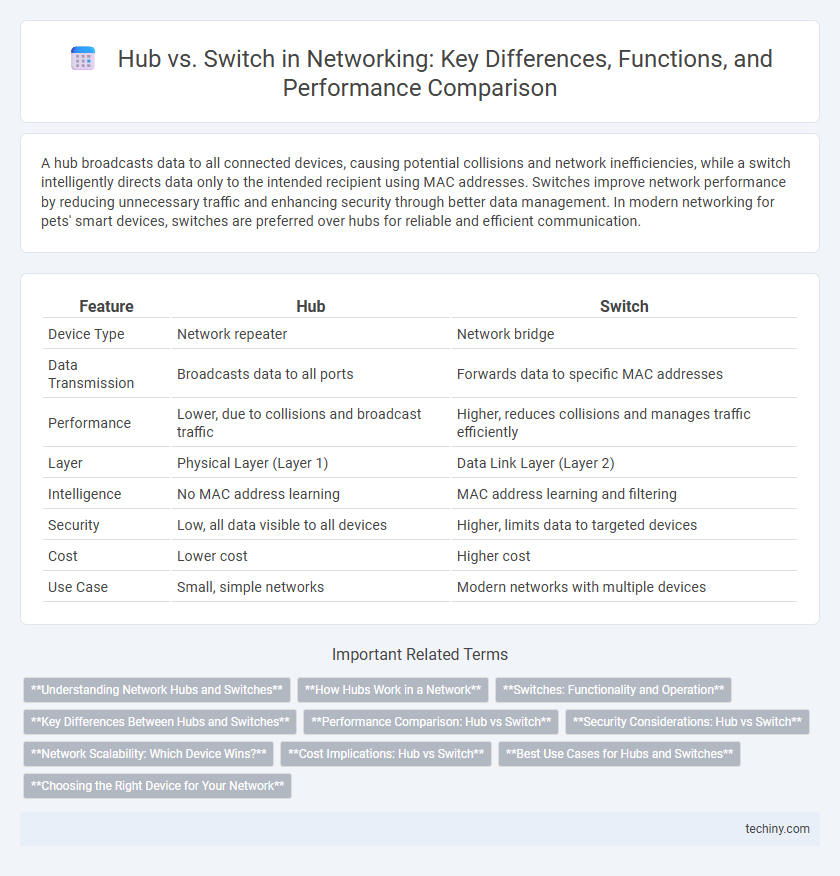A hub broadcasts data to all connected devices, causing potential collisions and network inefficiencies, while a switch intelligently directs data only to the intended recipient using MAC addresses. Switches improve network performance by reducing unnecessary traffic and enhancing security through better data management. In modern networking for pets' smart devices, switches are preferred over hubs for reliable and efficient communication.
Table of Comparison
| Feature | Hub | Switch |
|---|---|---|
| Device Type | Network repeater | Network bridge |
| Data Transmission | Broadcasts data to all ports | Forwards data to specific MAC addresses |
| Performance | Lower, due to collisions and broadcast traffic | Higher, reduces collisions and manages traffic efficiently |
| Layer | Physical Layer (Layer 1) | Data Link Layer (Layer 2) |
| Intelligence | No MAC address learning | MAC address learning and filtering |
| Security | Low, all data visible to all devices | Higher, limits data to targeted devices |
| Cost | Lower cost | Higher cost |
| Use Case | Small, simple networks | Modern networks with multiple devices |
Understanding Network Hubs and Switches
Network hubs operate as basic devices that broadcast incoming data packets to all connected devices, causing potential collisions and network inefficiency. Switches improve network performance by intelligently directing data packets to specific devices using MAC address tables, reducing collisions and enhancing bandwidth allocation. Understanding the operational differences between hubs and switches is crucial for optimizing network design and ensuring efficient data communication.
How Hubs Work in a Network
Hubs operate as basic networking devices that transmit data packets to all connected devices on a network segment without filtering or directing traffic. They function at the physical layer (Layer 1) of the OSI model, broadcasting incoming signals to every port and causing potential data collisions. Unlike switches, hubs lack intelligence for packet switching, making them less efficient for handling network traffic in modern LAN setups.
Switches: Functionality and Operation
Switches operate by creating a dedicated communication path between source and destination devices using MAC address tables, significantly reducing network collisions compared to hubs. They perform intelligent packet forwarding by examining the destination MAC address and directing data only to the intended port, enhancing network efficiency and security. Managed switches offer features like VLAN segmentation, Quality of Service (QoS), and port mirroring to optimize traffic management in complex network environments.
Key Differences Between Hubs and Switches
Hubs operate by broadcasting incoming network data to all connected devices, resulting in increased traffic and potential collisions, whereas switches intelligently direct data packets only to the specific device intended, reducing network congestion and improving efficiency. Unlike hubs that function at the physical layer (Layer 1) of the OSI model, switches operate at the data link layer (Layer 2), enabling MAC address-based filtering and segmentation of collision domains. Additionally, switches support full-duplex communication, enhancing bandwidth utilization, while hubs rely on half-duplex transmission, limiting overall network performance.
Performance Comparison: Hub vs Switch
Switches significantly outperform hubs in network performance by reducing collisions through packet switching and segmenting collision domains. Unlike hubs that broadcast data to all connected devices, switches intelligently forward data only to the intended recipient, enhancing bandwidth efficiency and reducing network congestion. This leads to faster data transfer rates, improved security, and optimized overall network throughput.
Security Considerations: Hub vs Switch
Switches enhance network security by segmenting traffic and reducing the risk of data interception, unlike hubs that broadcast all packets to every connected device, increasing vulnerability. Switches support features like VLANs and MAC address filtering, which help prevent unauthorized access and improve traffic isolation. Hubs lack these capabilities, making them less secure in modern network environments where data confidentiality is critical.
Network Scalability: Which Device Wins?
Switches outperform hubs in network scalability by efficiently managing data traffic with MAC address tables, enabling communication between multiple devices simultaneously without collisions. Hubs broadcast data to all connected devices, causing increased collisions and network congestion as the number of devices grows. In larger networks, switches maintain higher performance and reduce latency, making them the preferred choice for scalable network infrastructure.
Cost Implications: Hub vs Switch
Hubs generally have lower upfront costs compared to switches due to their simpler design and limited functionality, making them cost-effective for small, basic network setups. Switches, while more expensive initially, offer better efficiency and scalability by managing data traffic intelligently, reducing network congestion and minimizing downtime-related expenses. Investing in switches can lead to long-term savings through improved network performance and reduced maintenance costs.
Best Use Cases for Hubs and Switches
Hubs are best suited for small, simple networks where cost-efficiency is critical and minimal traffic management is acceptable, such as in home or small office setups with limited devices. Switches excel in larger, more complex networks requiring efficient data handling, higher bandwidth, and improved security, making them ideal for enterprise environments and data centers. Deploying switches reduces network collisions and enhances overall performance through intelligent traffic routing and segmentation.
Choosing the Right Device for Your Network
Selecting the right networking device depends on factors such as network size, traffic volume, and security needs. Switches efficiently manage data by forwarding packets directly to specific devices, reducing collisions and improving overall network performance. Hubs, while simpler and cheaper, broadcast data to all connected devices, making them suitable only for small or less complex networks.
Hub vs Switch Infographic

 techiny.com
techiny.com